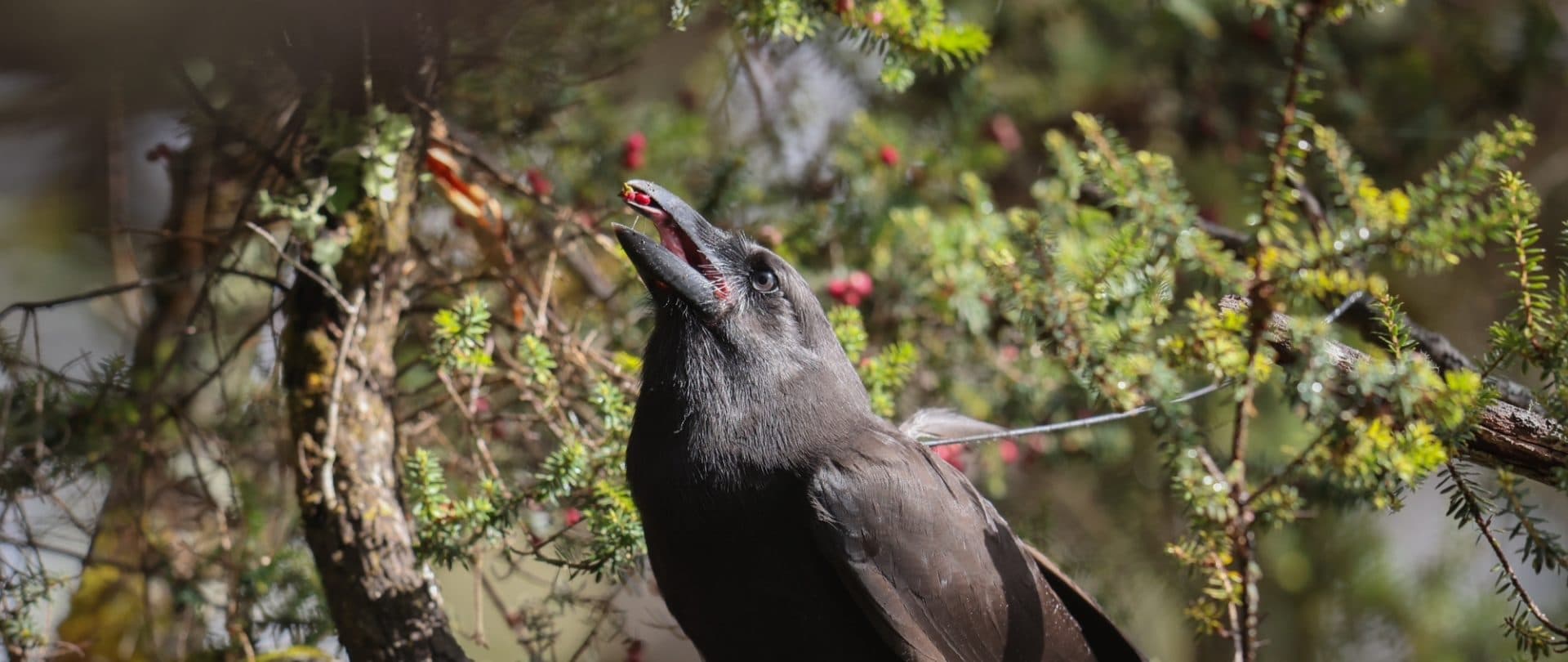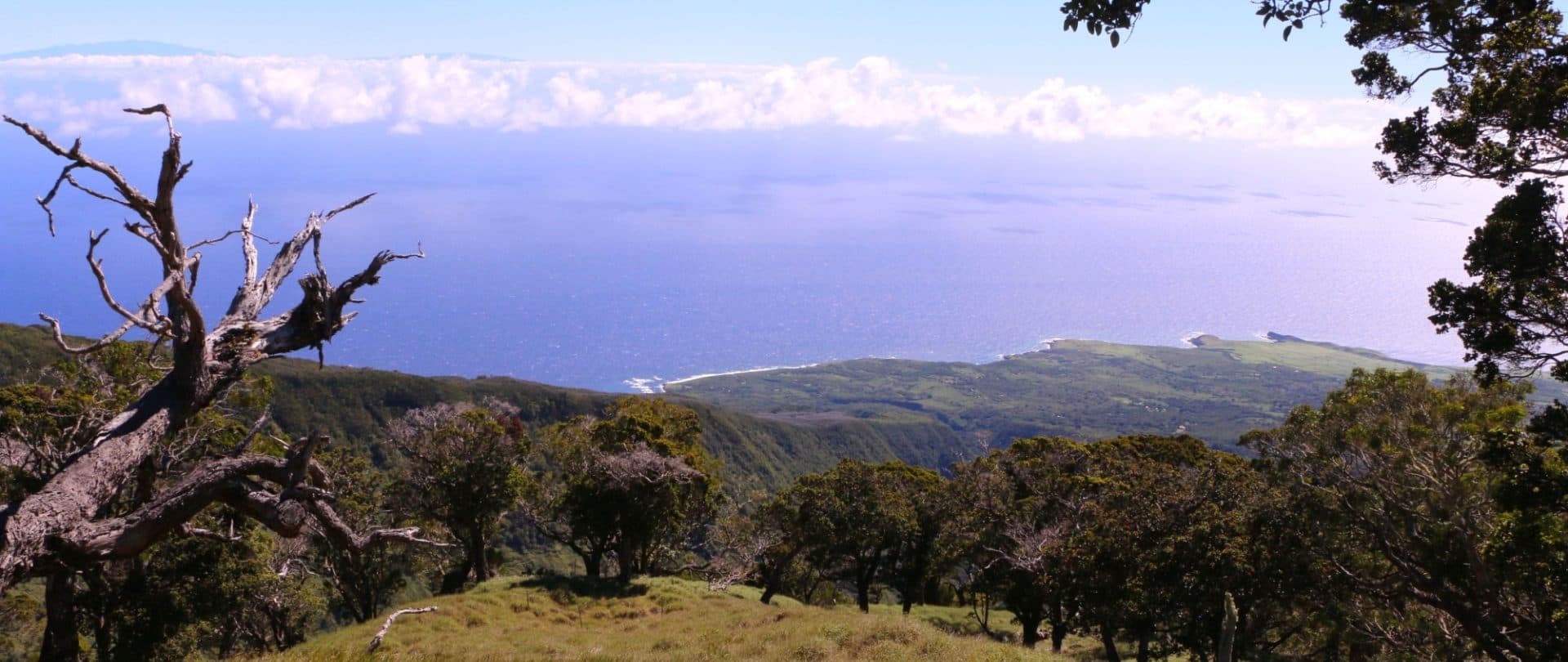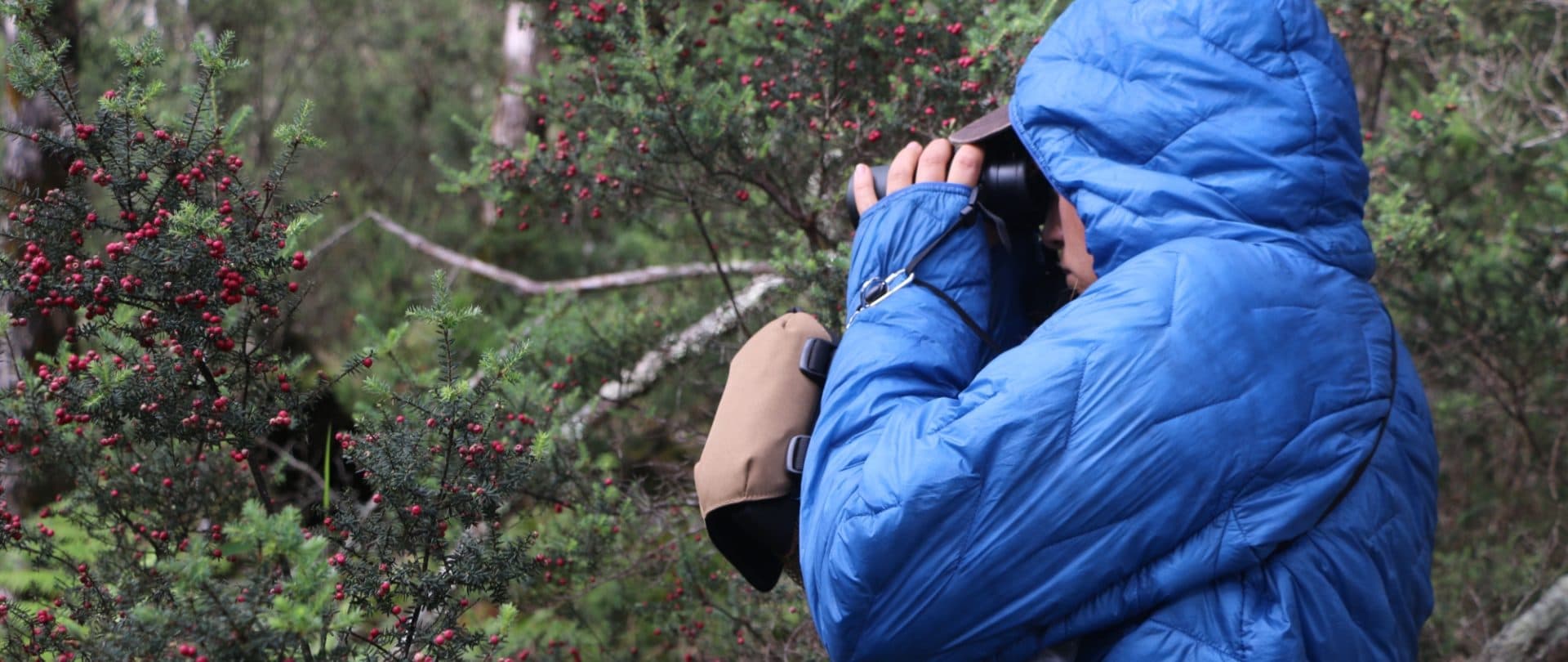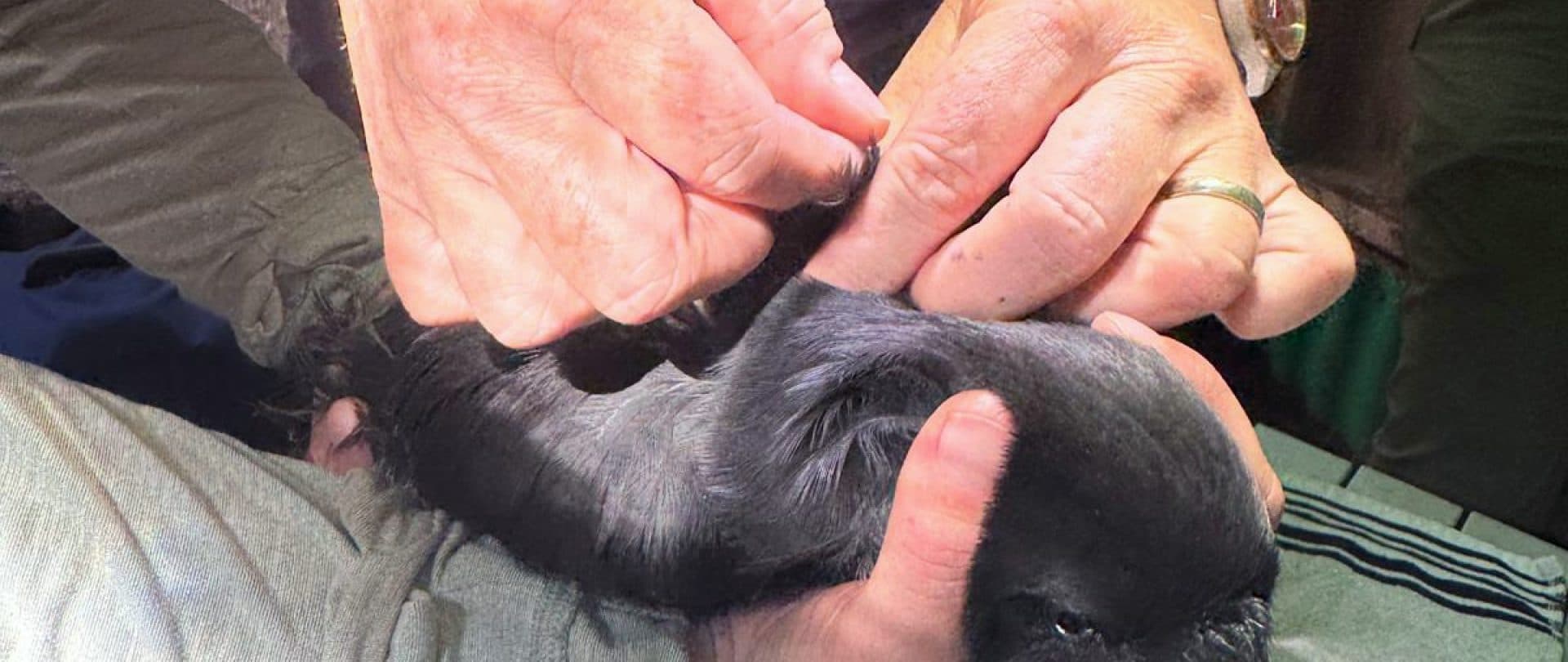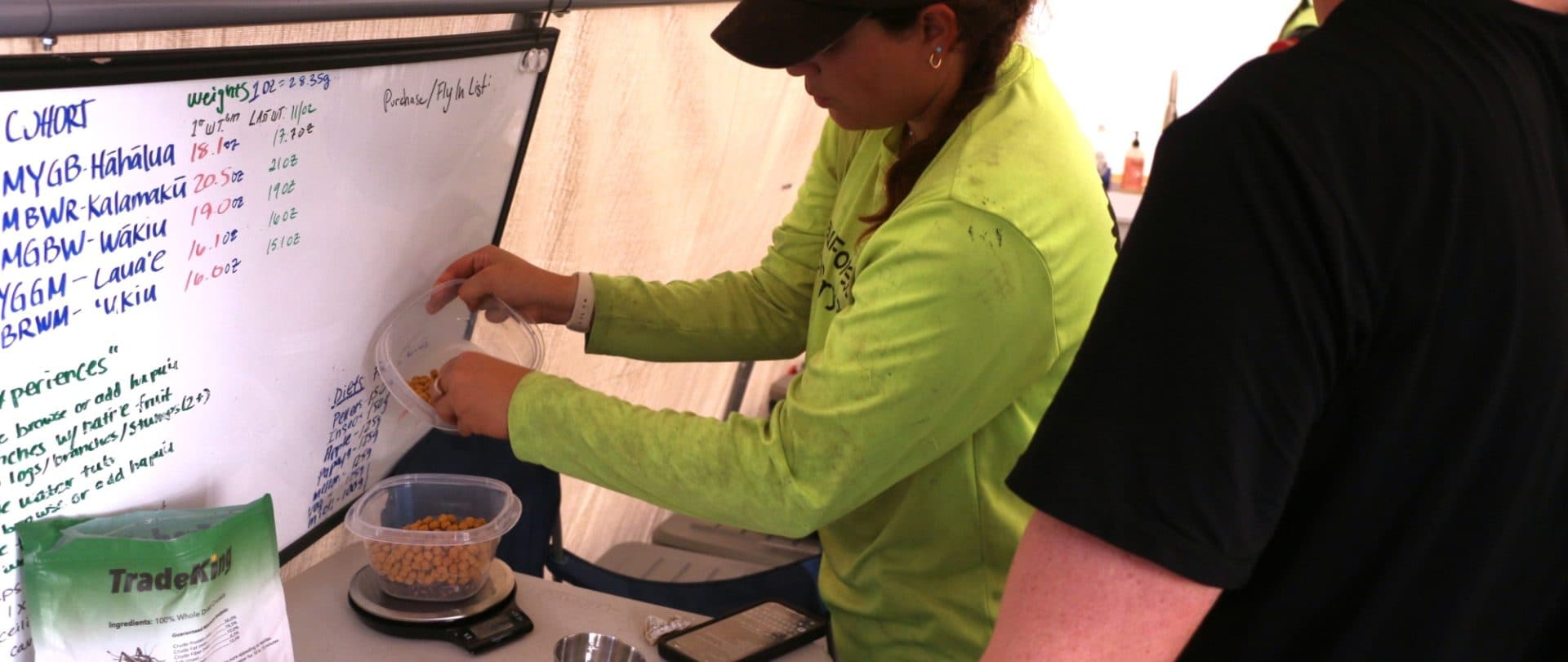Survival Mode
The return of an ancient voice to Maui's forests
BY Sara Stover
An ancient voice calls from the branches of an ‘ōhi‘a lehua tree, echoing across the verdant forest. Hawai‘i’s native crow, ‘alalā, forages for ‘ōlapa (native forest trees), one of his favorite meals, before soaring above the slopes of Haleakalā, calling to the other recently-released crows. Despite being born into captivity, the native intelligence of ‘alalā emerges after it spends time in its natural habitat.
Today, many of Hawai‘i’s plants and animals are only alive in captivity, earning the state the unfortunate nickname of the “extinction capital of the world.” Disease and habitat loss are an ongoing threat to native wildlife, including ‘alalā. Considered extinct in the wild, the future looked bleak for the boisterous bird with ink-black feathers and a large beak. Fortunately, a conservation effort known as the ‘Alalā Project is restoring ‘alalā to the wild.
A rare species of crow, ‘alalā is only found in Hawai‘i and is the largest surviving endemic Hawaiian forest bird. Of the five native Corvid species once found on at least four of the main Hawaiian Islands, ‘alalā, or Corvus hawaiiensis, is the sole survivor.
In the early 1800s, ‘alalā were known to exist throughout Hawai‘i Island, and their documented forest habitats ranged from 1,000 feet to about 8,200 feet in elevation. The population of ‘alalā experienced a dramatic drop after the arrival of Western settlers in the 1820s, which brought an onslaught of threats to their survival in the wild. Like many other native forest birds, the primary threats included invasive species, introduced disease and habitat loss. Mongoose, rats, free-ranging cats and other non-native species preyed on ‘alalā and their eggs, and spread diseases. Mosquitoes brought in unintentionally by ships carried diseases such as avian malaria and avian pox.
‘Alalā’s native forest habitat was converted for agriculture and livestock grazing, destroying the amount of forest cover on the islands and escalating the threat. As more invasive plant and animal species were introduced, the native forest that the ‘alalā called home continued to shrink and the quality of remaining forest was compromised. The implications were devastating both ecologically and culturally, as the ‘alalā have a sacred place in Native Hawaiian culture as ‘aumākua (spiritual family guardians or deities).
By 1976, the number of individual ‘alalā had dwindled to 76, and it was clear that the dry and semi-dry forest dwellers would go extinct without intervention. Like Hawai‘i’s native tree snails, honeycreepers and other species, ‘alalā would need to be brought into captivity to prevent extinction altogether.
By 1992, only thirteen Hawaiian crows remained. Faced with a biodiversity crisis, conservation agencies resorted to gathering individual ‘alalā from the wild population and bringing them into captivity at the Keauhou Bird Conservation Center on Hawai‘i Island in 1993. It was a move that would prove pivotal to the crow’s existence, as the very last pair of ‘alalā disappeared from Hawai‘i Island’s South Kona district in 2002, marking the year of their extinction in the wild.
With the help of a captive breeding program started at the Keauhou Bird Conservation Center, the species has beaten the odds so far. The initial captive population was composed of less than ten genetic founders, making all the ‘alalā in existence their fifth-generation grandchildren. Releasing these descendants back into the wild, however, has its challenges.
In 2016, wildlife officials attempted to release 29 captive ‘alalā into the Pu‘u Maka‘ala Natural Area Reserve on Hawai‘i Island, where they were traditionally found. By 2019, there was a spike in the mortalities of a group of the released ‘alalā due to ‘io (the Hawaiian hawk), a native predator who lives there, as well as introduced predators and inclement weather. Although they once coexisted with ‘io, the ‘alalā became conditioned to human care while in captivity, making them easy prey in the wild. As ‘alalā’s numbers dropped, officials were forced to recapture the remaining five crows and return them to the conservation breeding program.
For years, the only places to find the remaining ‘alalā have been the Keauhou Bird Conservation Center and the Maui Bird Conservation Center, which are part of the Hawai‘i Endangered Bird Conservation Program. Today, over 110 ‘alalā are in captivity through the program, with less than half at the Maui Center and the rest at Keauhou.
Over the last few years, Maui Forest Bird Recovery Project and the ‘Alalā Project partners, including the U.S. Fish and Wildlife Service, the DLNR Division of Forestry and Wildlife and the San Diego Zoo Wildlife Alliance, which manages the Bird Conservation Program, shifted collaborative efforts to preparing the ‘alalā for release on the hawk-free island of Maui. For over two years, the partners worked tirelessly on research, planning, cultural and biological assessments, breeding, caretaking, funding, community outreach and training the birds for life in the wild. The ‘alalā selected to be released on Maui were around one-year old, making them less territorial and more adaptable to new environments.
For the initial release, two female and three male juveniles were chosen for their highly developed behavioral and social skills that could improve their odds of surviving in the wild by foraging, avoiding predators and bonding. In October 2024, the five young ‘alalā were released in the remote Kīpahulu Forest Reserve on Haleakalā’s leeward slopes. On the day of the pilot release, the ‘alalā were blessed with a traditional Hawaiian cultural send-off before beginning the journey to their new forest home by helicopter.
“I was there for the release of the cohort of ‘alalā. Aviculture specialist Tess Hebebrand and I worked together to open and secure the door. It definitely was an emotional and exciting day. To think of all the people who had worked to get the species to a point where we could be doing something like that felt like a lot of responsibility,” says Martin Frye, Maui Forest Bird Recovery Project’s research field supervisor, of the first reintroduction attempt to take place outside of Hawai‘i Island. “Still more overwhelming is realizing that there are around 105 cousins of these five birds who are still captive, and that not just their fate as individuals, but their entire species depends on us and the cohort to figure it out.”
“We translocated the ‘alalā into the field in October, but they stayed in a soft-release aviary for about six weeks before we let them out of captivity in November 2024. The birds spent several weeks in a field aviary at the release site learning to use the automated feeder boxes, which distribute food on-demand as a supplement to the birds’ wild diet, and getting accustomed to wearing their new backpacks,” says Marty, referring to the small, light GPS trackers attached to a durable cloth harness and worn by ‘alalā as a backpack, providing a method to track the birds in addition to VHF radio telemetry. Although the ‘alalā have a netted enclosure they can retreat to if needed, they have spread their wings a bit more, venturing deeper into the forest over time.
After generations in captivity, becoming wild again will be a process for ‘alalā. Although the captivity program’s caretakers minimized human contact as much as possible, the birds still need to adapt to foraging for food independently. For now, the Hawaiian crows are being carefully monitored and cared for daily by Maui Forest Bird Recovery Project and San Diego Zoo Wildlife Alliance staff.
“At the moment, our focus is the ‘alalā’s distribution around the release site, their proximity to one another and their use of both the forest and the supplemental feeders,” Marty adds. “They all started out together in captivity and their ability to fly long distances was something they had to build up to. Now that they have been unfettered since November, they are stronger and use more space than they did at first. As they mature, their desire to have space or be near one another will undergo still more changes, including territoriality and hopefully, also, pair bonding.”
For certain native Hawaiian species in captivity that are threatened by introduced diseases, habitat loss or alteration and non-native species, release into the wild remains a distant prospect. “Reintroductions are challenging, but they often include lots of hard and valuable lessons,” says Marty, who hopes the lessons learned from the ‘alalā’s reintroduction can be applied to other endangered native species.
“A major goal of the pilot release on East Maui is to see what the ‘alalā can do with a good chunk of time in the absence of the ‘io. They need time to experience the forest, time to use their environment in different ways, and time to be themselves just existing within their own home,” Marty says.
“The crows have kept their weights up. One really positive sign is after some heavy storm events, all of the birds were keeping themselves dry. They evidently found shelter and maintained the waterproofing in their plumage, meaning they have the skills to survive inclement conditions. They make strong flights from tree to tree, and can now go high above the trees or soar out in the open above the forest,” shares Marty. “Their social cohesion has remained stable, and they can cruise around together or be by themselves. We have observed them using native plants for foraging behaviors, including picking out invertebrates and eating some native fruits as well. Of course, they are all a little different as individuals, but the crows are doing well.”
For the first time in years, ‘alalā is free to fly and explore its home in the wild. As the ‘Alalā Project continues to help increase the crows’ numbers and encourage wild behaviors, ‘alalā and ‘io may be able to coexist once again. Ultimately, the initial release of ‘alalā could lead to future releases on Maui and Hawai‘i Island.
“The ‘alalā impress all who are fortunate to experience them. When you hear them, you become aware of an ancient voice that commands your attention. As they move about the forest, you cannot help but notice the potent force of their will,” says Marty. “By far, the most rewarding experiences with alalā are those shared with others. Looking out at the world, there are so many tragedies of the commons, and the near extinction of the ‘alalā is a big one. We have collectively lost so many things and forgotten many more. A lot of people, agencies and partnerships have been working on recovering ‘alalā for decades. Our work here on Maui is just a stepping stone along the path to the larger recovery effort, and we are continuously humbled by the responsibility we have to carry that effort forward.”
Find out how to support the Maui Forest Bird Recovery Project as a volunteer, donor or bird sponsor at MauiForestBirds.org. Learn how the ‘Alalā Project partners are working to return ‘alalā safely to Hawaiian forests at AlalaProject.org.
